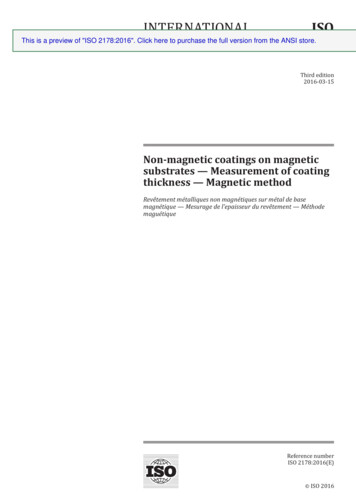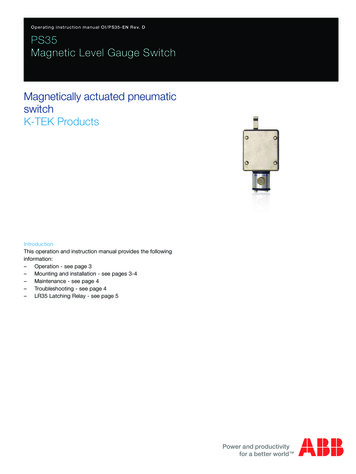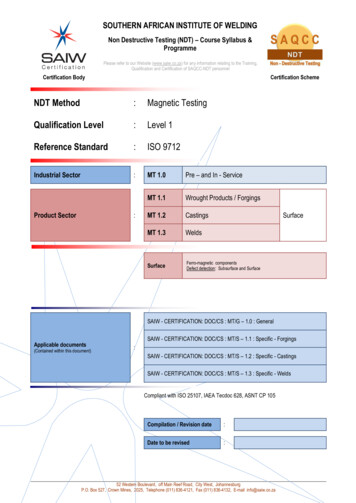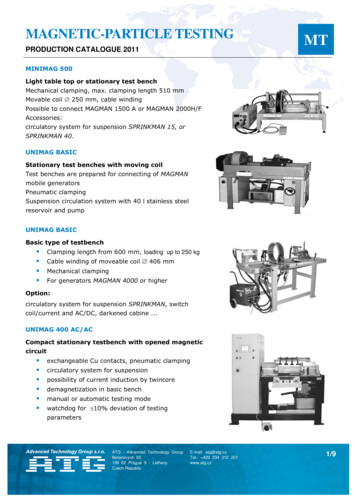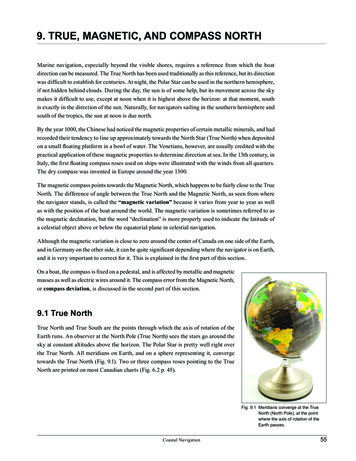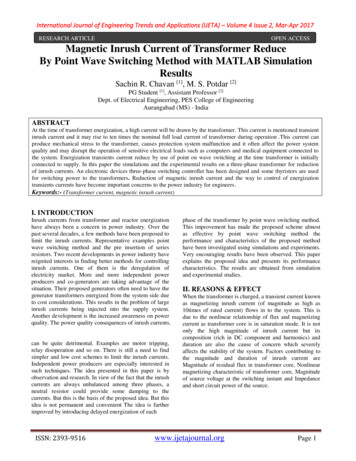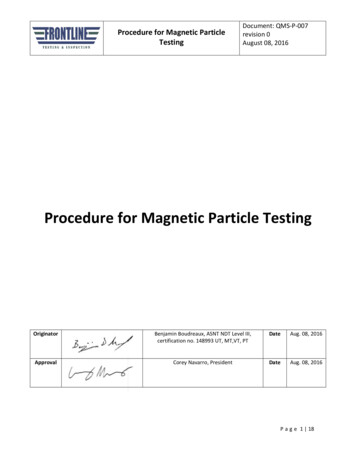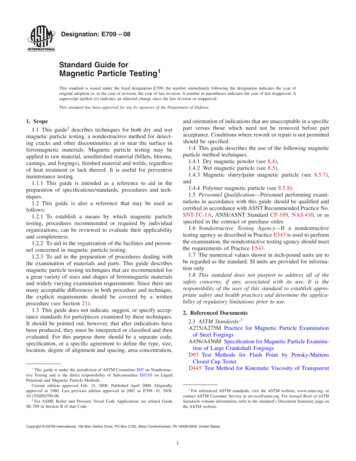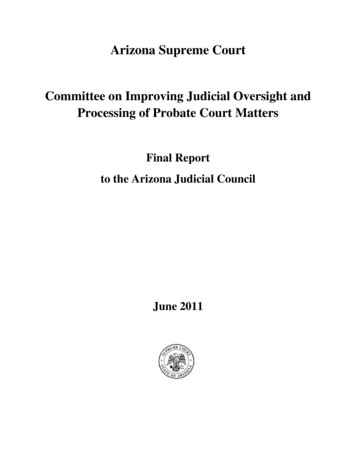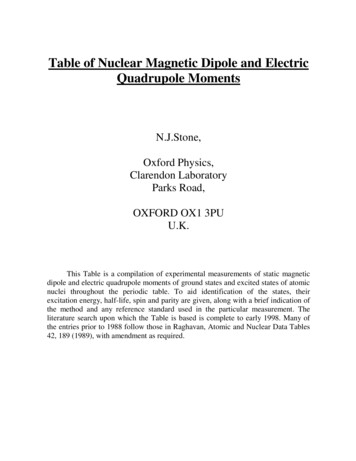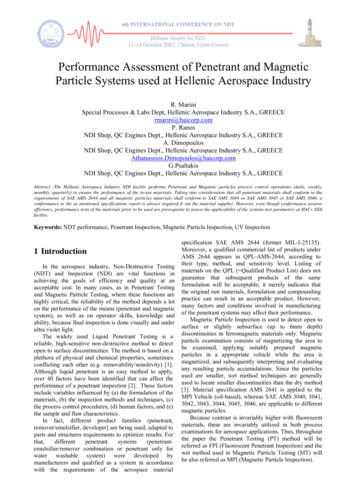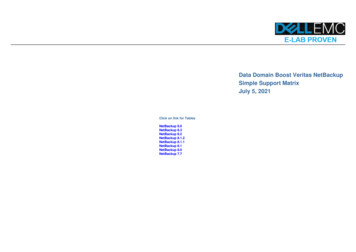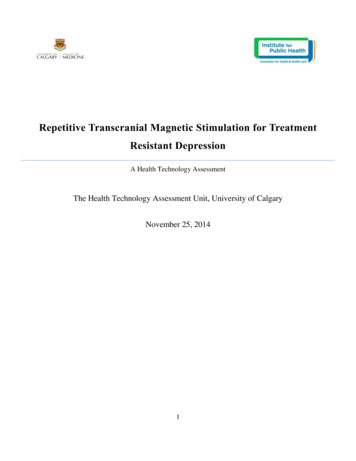
Transcription
Repetitive Transcranial Magnetic Stimulation for TreatmentResistant DepressionA Health Technology AssessmentThe Health Technology Assessment Unit, University of CalgaryNovember 25, 20141
AcknowledgementsSupported by a financial contribution from Alberta Health through the Alberta Health Technologies DecisionProcess, the Alberta model for health technology assessment and policy analysis. The authors thank themembers of the Expert Advisory Group for their technical assistance: Dr. Michael Demas, Ms. Linda Dziuba,Dr. Lana Hawkins, Dr. Adam Kirton, Dr. Frank MacMaster, Mr. Daniel Scott, Dr. Michael Trew, and Dr. DougUrness. We also thank the Alberta Health Review Team for their guidance. We would also like to extend oursincere thanks to all participants in the key informant interviews to inform the social context component of thisreport. We gratefully acknowledge their valuable contribution to this HTA and thank them for their support.The views expressed herein do not necessarily represent the official policy of Alberta Health.This report is authored by Laura E. Leggett, Stephanie Coward, Lesley J.J. Soril, Gail Mackean,Diane Lorenzetti, and Fiona Clement on behalf of the Health Technology Assessment (HTA) Unit at theUniversity of Calgary. The authors declare no conflict of interests. The authors abide by the Conflict ofInterest/Non-disclosure Agreement with Alberta Health.2
Table of ContentsTable of Contents . 3Abbreviations . 6Executive Summary . 71Purpose of this Health Technology Assessment. 101.1Policy Question and Research Objectives . 102Background Information. 112.1Major Depressive Disorder . 112.2Risk Factors for Major Depressive Disorder. 112.3Diagnosis of Major Depressive Disorder . 122.4Current Care Patterns for Major Depressive Disorders . 122.5Treatment Resistant Depression . 132.6Repetitive Transcranial Magnetic Stimulation . 132.6.1Target Populations . 142.6.2Contraindications for use of Technology. 143Social Context. 153.1Research Objective . 153.2Methods . 153.3Findings . 163.3.1Treatment resistant depression in Alberta. 163.3.2Current treatment options for treatment resistant depression . 173.3.3Access to repetitive transcranial magnetic stimulation for treatment resistant depression andcurrent practice in Alberta and Canada . 193.3.4Clinician experience with repetitive transcranial magnetic stimulation in Alberta . 213.3.5Perspectives on the patient experience with repetitive transcranial magnetic stimulation . 253.3.6Capacity for providing repetitive transcranial magnetic stimulation in Alberta. 263.3.7Conclusions . 324Patient Experience with Repetitive Transcranial Magnetic Stimulation . 334.1.1Research Question . 334.1.2Methods. 334.1.3Results . 35. 35. 354.1.4Conclusions . 395Safety and Efficacy of Repetitive Transcranial Magnetic Stimulation . 415.1Research Objective . 413
5.2Methods . 415.2.1Literature Search . 415.2.2Selection of Literature. 415.2.3Data Extraction . 435.2.4Quality Assessment . 435.2.5Statistical Analysis . 445.3Results of Technology Effects and Effectiveness . 445.3.1Regulatory Status . 445.3.2Summary of Findings . 455.3.3Characteristics of Included Studies . 475.3.4Repetitive Transcranial Magnetic Stimulation Compared to Sham . 485.3.5High Frequency Repetitive Transcranial Magnetic Stimulation Compared to Low FrequencyRepetitive Transcranial Magnetic Stimulation . 705.3.6Unilateral Repetitive Transcranial Magnetic Stimulation Compared to Bilateral RepetitiveTranscranial Magnetic Stimulation . 825.3.7High Intensity Repetitive Transcranial Magnetic Stimulation Compared to Low IntensityRepetitive Transcranial Magnetic Stimulation . 885.3.8Repetitive Transcranial Magnetic Stimulation Compared to Various other Repetitive TranscranialMagnetic Stimulation Protocols . 955.3.9Repetitive Transcranial Magnetic Stimulation Compared to Electroconvulsive Therapy . 1065.4Discussion . 1146Cost-Effectiveness and Economic Impact . 1166.1Research Objectives . 1166.2Review of Economic Literature . 1166.3Methods . 1176.3.1Economic Model . 1176.3.2Model Inputs . 1186.3.3Uncertainty Analysis . 1206.4Results . 1216.4.1Standard therapy compared to repetitive transcranial magnetic stimulation . 1216.4.2Repetitive transcranial magnetic stimulation compared to Electroconvulsive therapy . 1226.4.3Budget Impact Analysis . 1246.5Discussion . 1266.6Conclusions . 1277 Systematic Review of rTMS for Treatment Resistant Youth and Young Adults with Unipolar or BipolarDepression. 1287.1Introduction . 1287.2Methods . 1297.3Results . 1317.3.1Study Characteristics . 1314
7.3.2Quality Assessment of Included Studies. 1347.3.3Effectiveness of Repetitive Transcranial Magnetic Stimulation . 1367.3.4Safety . 1367.4Discussion . 1367.5Conclusion. 1378Limitations . 1389Conclusions . 13910Appendix A: Mental Health Service Delivery in Northern Alberta . 14011Appendix B: Search Strategy for Review on Patient Experiences with rTMS. 14212Appendix C: Search Strategy for Systematic Review of Adult Literature . 14513Appendix D: Search Strategy for Systematic Review on the Effectiveness of rTMS for TreatmentResistant Youth and Adolescents with Uni- or Bi-polar Depression . 1485
AbbreviationsBDIBeck Depression InventoryCANMATCanadian Network for Mood and Anxiety TreatmentsCGIClinical Global ImpressionCIConfidence IntervalDLPFCDorsolateral Prefrontal CortexDSMDiagnostic and Statistical ManualEAPEmployee Assistance ProgramECTElectroconv
The magnetic field is created by a plastic-encased coil which is placed over the patient’s scalp. rTMS therapy was approved by Health Canada for clinical delivery in Canada in 2002. Currently, two rTMS machines are licensed without any age or clinical indication restrictions. Methods:
